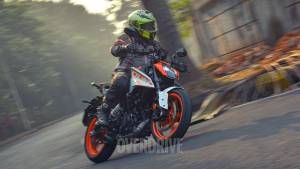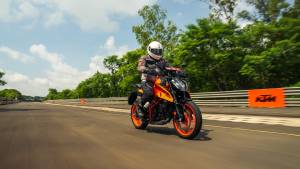Things you wanted to know about the KTM 390 Duke, but didn't know who to ask
There's been a lot of interest in the 390 since before its launch, and we've been fielding questions across Facebook, Twitter and OVERDRIVE's email accounts. So here's the most commonly asked questions and their answers.
1. Will it run on standard fuel?
The science of it is that the higher the compression ratio on an engine, the more sensitive the engine becomes to the quality of the fuel. Bad fuel basically won't ignite or burn as cleanly and eventually can cause pinging or detonation which slowly eats engines. 12.6:1 is considered a high ratio, though high performance production engines do go higher. However, KTM has run this kind of compression for a while now - the Duke 125 has a similarly high compression ratio - on Indian made platforms and it seems to work, at least in the markets the Duke 125 goes to.
We spoke to Bajaj and they told us that they have had a select group of customers running 390 Dukes on a closely monitored real use in the real world test a standard process before most launches. And these customers have been using regular pump gas just like they would on their normal motorcycles with no reported problems so far.
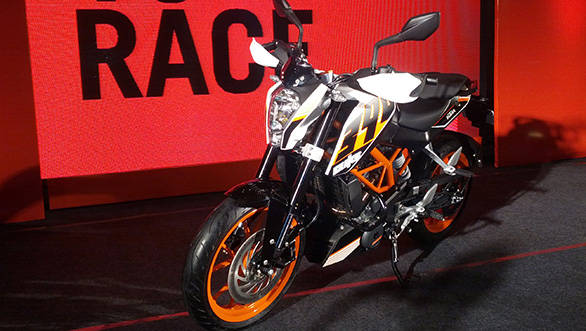 The KTM 390 Duke will run just fine on regular unleaded fuel
The KTM 390 Duke will run just fine on regular unleaded fuel
2. Will it tour?
I spent roughly 240km in the saddle with one large break and several short breaks (to let slower riders catch up) and no one in our group, or indeed in any other group on our riding day in Salzburg complained. But let us look at it from the chassis and comfort side first. If you approach this question from the simple angle that the chassis and ergonomics are more or less the same as the Duke 200, then the answer is quite easy. You see, I've done a few 1000kmover the last year and every time I've reached the same conclusions.
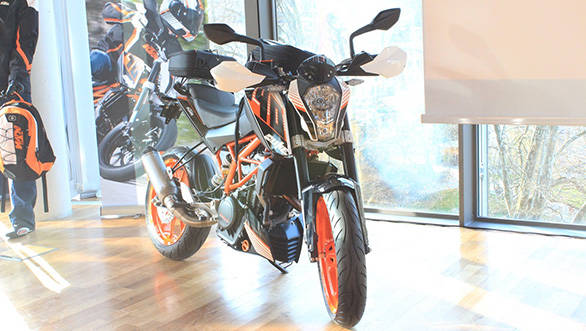 Mounting luggage on the 390 Duke can be a bit of bother
Mounting luggage on the 390 Duke can be a bit of bother
Firstly, mounting luggage on the Duke 390/200 is going to be a bother. The rear seat is pretty small and tail bags require unnecessary precision to mount so that they don't impinge on your space. Two-up touring is impossible without significant mods creating space for luggage as well as for the pillion. I use a set of Kriega tail bags for which I created a rather simple set of nylon loops that mount where the grab rail would normally go that function as super-effective bungee points. The genius bit is that they lift off the paintwork when you use them, which makes them non-scratch.
Second, in terms of riding position, the Duke is cramped on long rides. This become more obvious if you're going at a steady pace and then need to shift around in your seat. You will discover that unless you are Marc Marquez-sized there isn't much squirming room. In my case, upping the pace solves this issue but it exists. The biggest ergonomics issue though is the footpeg position, which is a bit extreme and towards the end of the (thousand kilometre) riding day, I came to realise that the peg position is the biggest hindrance to touring rather than all the other niggles.
However, the upsides are also there. First, the seat might seem super-hard but it remains exactly the same for hours together and a numb bum isn't a KTM attribute. Second, the seat does, over time, take the shape of your bum ever so subtly which makes riding long distances quite easy on the rear-end. Third, there is no buzz from the handlebars to speak of which means even with sustained high revs on the 200 (for example), buzzy hands isn't a KTM attribute either.
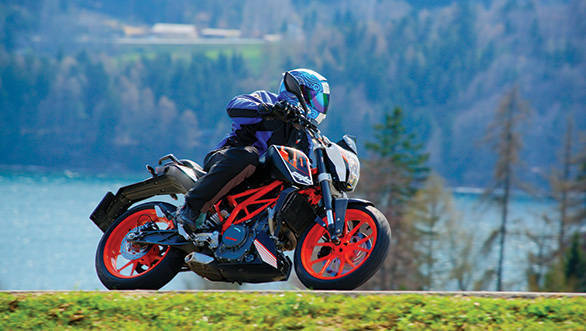 The 390 Duke can tour alright, but not as well as it can corner
The 390 Duke can tour alright, but not as well as it can corner
And finally, the KTM is extraordinary at holding on to its fuel economy even at stupidly high revs which means at a quick clip, more able touring motorcycles with bigger fuel tanks end up offering the same range as the KTM. Which is, oddly enough, a source of quiet satisfaction for the KTM rider. Actual range on the 200 between tankfuls (quarter tank to quarter tank) is about 225-240km and we expect the 390 to more or less exactly match or slightly exceed that figure. Yes, exceed. We believe the 390 will prove a little more frugal than the 200 in the real world because you'll carry lower revs everywhere and the tall sixth will really be a boon to economy on the highway.
That brings us to the engine end of things. As I noted in my first ride story, 100kmph is 5,000rpm in sixth and 120kmph is 6,500rpm. These revs are quite comfortable for sustained highway work on the KTM and that alone changes the nature of the highway game for the KTM. The 200 was frantic and sustained 120kmph, apart from being illegal, was strenuous because it meant you had to sit at 8,500rpm or higher all the time. A few of us are mechanically insensitive enough to handle that kind of riding but most aren't. The 390 solves that problem with its extra power and adds to its longer-legged feel (over the 200) with the the sixth gear ratio.
The KTM 390 is probably not going to be as comfortable a tourer as the Honda CBR250R. The Honda remains our current pick of the Indian touring motorcycle until we test and verify the 390 Duke on the highway. But, the 390 will be the bike offering both greater average speeds and average fuel economy on the open road. The CBR will have better ride quality and more space for the rider and luggage. But the KTM promises to be an extremely effective long-distance tool. This is a comparison test we at OVERDRIVE are looking forward to.
3. Can I ride two-up?
Of course. But please keep it to a minimum. Pillion space has always been at a premium on the KTM Duke and the 390 adds nothing to make things better. If you like wearing a backpack on the bike, you've more or less occupied all the space the pillion might have had. Overall, city trips should be okay but longer trips two-up are going to be hard on the pillion without a doubt.
4. What bits do I add to stock bike?
The KTM comes with comprehensive equipment but here is what we would add to the bike. We would throw away the metal crash guard and replace that with classier crash bungs. R&G sell theirs in India via Performance Racing Store. We have crash tested these and they work but because they are imported they are expensive too. In our experience, the swingarm spool (aka cotton reels) and the radiator guards are must haves. Expect to pay about Rs 16-18,000 for the full set. Performance Racing also has protectors from another brand, Vortex.
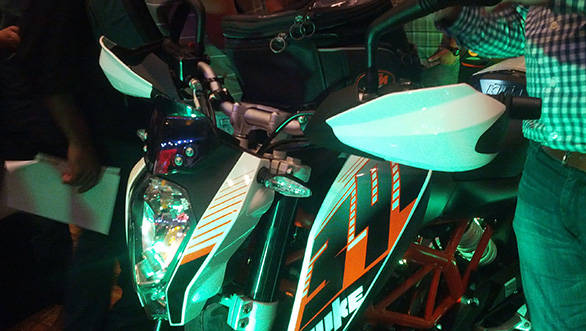 On the Indian 390, handguards are part of standard equipment
On the Indian 390, handguards are part of standard equipment
A cheaper alternative is to order from jcMoto. jcMoto makes bar-end sliders and frame sliders (aka crash bungs). Again, we have crash tested these and can attest to their effectiveness. We do wish jcMoto would add fork sliders and swingarm spools to their line-up as well. The whole set should cost your about Rs 8,500 or so.
Tip: Remember that you have to loosen the top of the engine mounts to mount the plate the frame slider usually sits on. So double check that the bolts are torqued tight when you've finished mounting them.
Finally, KTM themselves also sell crash mushrooms although we have only ever found the front fork sliders (Rs 2200 approx, a year ago) in stock. Crash protection is a good place to start because though expensive, we know from experience that it does really work.
The only other thing we would add is to go to the 3M guys and get clear film protection for the painted and stickered bits. KTM skimps a little bit on cost by giving you stickers which are not protected by a clearcoat. A small investment in the 3M film goes a long way in making your bike look minty for longer. Again, we have tested the 3M film on our long-term Renault Duster and it does really work and is next to invisible.
Finally, do add a KTM powerpart or other scratch guard to the tank in the area where your belt or shirt buttons could scratch the tank.
5. What bits do I take off the stock bike?
Unless you regularly ferry your mom around, you can safely take off the saree guard. You can also take off the heavy splatter guard from the end of the swingarm quite easily. I like to add it back for the rains to ensure I don't roost the heck out of people behind me. And since installation and removal requires basically four bolts to be added/removed, it's an easy thing to do.
6. Do I really need this ABS stuff?
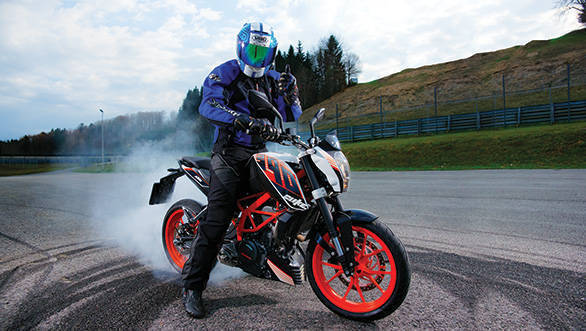 ABS, an absolute necessity on any vehicle is standard on the KTM 390 Duke
ABS, an absolute necessity on any vehicle is standard on the KTM 390 Duke
Yes. Undoubtedly yes. ABS or anti-lock brakes is a simple system in concept but its effectiveness in saving your skin cannot be understated. Even those of us who regularly practice braking and take motorcycles to full braking performance pretty often find it next to impossible to outperform ABS. And in wet or dusty conditions? ABS stops your bike quicker every single time.
In that sense, KTM offering ABS as standard on the 390 Duke is applause-worthy and other manufacturers really should take the step. In Europe, it will be soon be mandatory for motorcycles to offer standard ABS. And slowly but surely that day will come in India as well.
The way we see it, given how unpredictable our roads are, ABS shouldn't be optional at all no matter what you're buying. We would go so far as to say, spend whatever extra money you must and get an ABS-equipped motorcycle if you can.
7. Will it wade?
A lot of people wonder if the low-slung exhaust compromises the KTM's ability to handle deep water. And simple answer is that most vehicles can wade until their engine intake or exhaust port (thumb rule) is submerged. And the KTM does not have an exceptionally lower intake or exhaust port so it should wade as well or as badly as any other Indian motorcycle.
The thing to remember is that deep water requires a certain nuance to cross safely. You should be able to keep the throttle evenly open the whole time so the exhaust (even if fully underwater) has enough pressure from the exhaust gases to prevent water from being sucked into the engine. So be careful and it will wade.
8. I hear the KTM 200 was super-hot to ride in traffic. The 390 will be as well?
Well, yes. The KTM 200 Duke didn't really overheat in traffic but there is a problem there. The radiator fan, when it comes on, sucks hot air out of the radiator but pays no attention to where the hot air goes. And unfortunately, the engine splits the air into the two streams both of which end up on the rider's legs. This is why the 200 Duke feels super-hot when you're standing at a traffic light for instance. The 390 is likely to be the same.
On the other hand, remember this: higher performance means greater heat, a significant amount of which is wasted in all internal combustion engines. Which means that when you're striving for higher performance, you're going to have to learn to live with the heat it isn't really an option. Just ask any Indian superbike owners and they'll tell you that the heat is the primary reason why commuting to work everyday on these beauties isn't really all fun and games.
9. Add your questions in the comments and we'll answer the popular ones.
Other KTM 390 Duke coverage
In case you missed it, here's our KTM 390 Duke first ride
A list of on-prices for the KTM 390 Duke across India is here
What does the 390 mean for Royal Enfield? Analysis here
Starts Rs 8.49 Lakhs
1330cc
CVT
106
154
-NA-
Starts Rs 2,52,928
373cc
6-Speed
43.50
37.00
25.00 Kmpl
Starts Rs 1,64,143
250cc
6-Speed
26.50
22.90
-NA-
Starts Rs 1,72,749
200cc
6-Speed
25.00
19.50
27.27 Kmpl
Related Stories
Top Stories
Latest Videos
Most Popular
- Upcoming Mahindra XUV 3XO: All you need to know
- New Suzuki Swift spotted testing
- Nissan Magnite EZ-Shift review - is the AMT any good?
- 2024 Hyundai Creta vs Toyota Urban Cruiser Hyryder vs Skoda Kushaq comparison review - the hype is real?
- Budget Sportbike Showdown: Kawasaki Ninja 500 vs Aprilia RS 457 vs Yamaha YZF-R3
